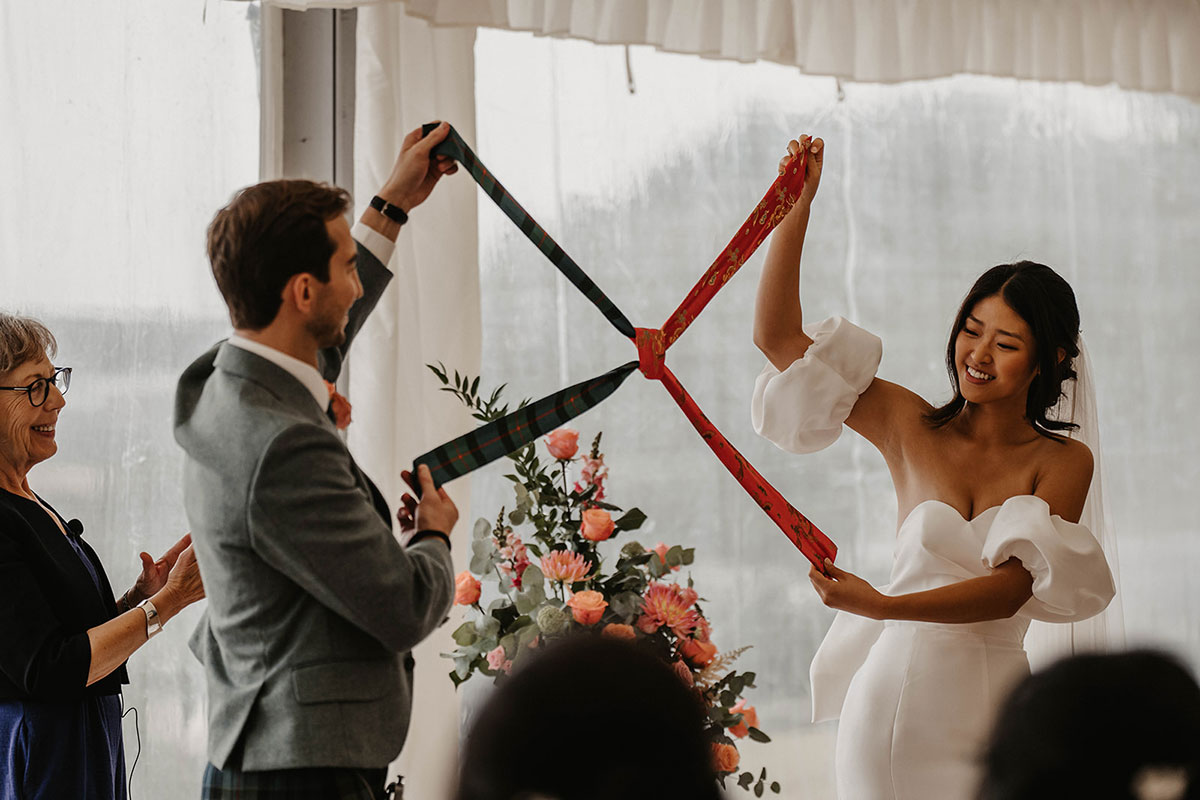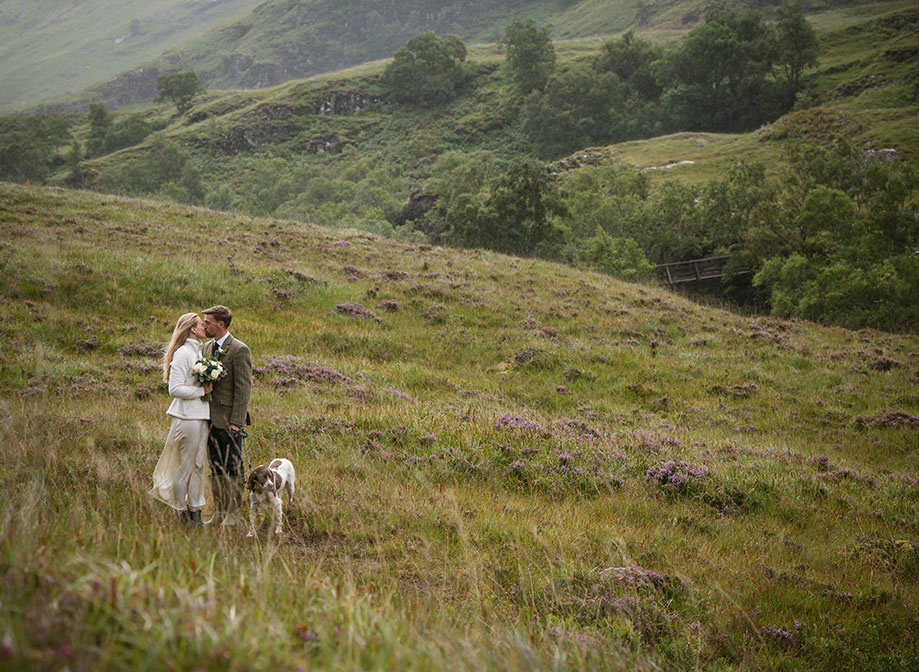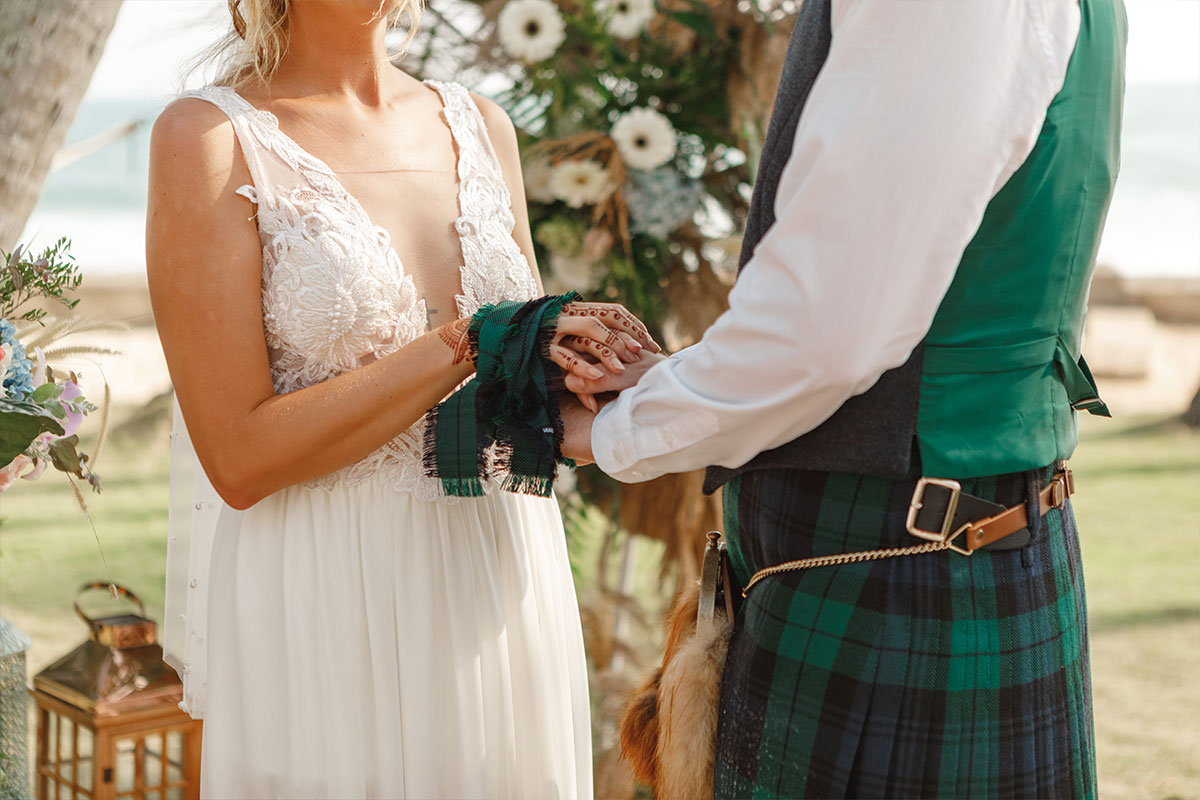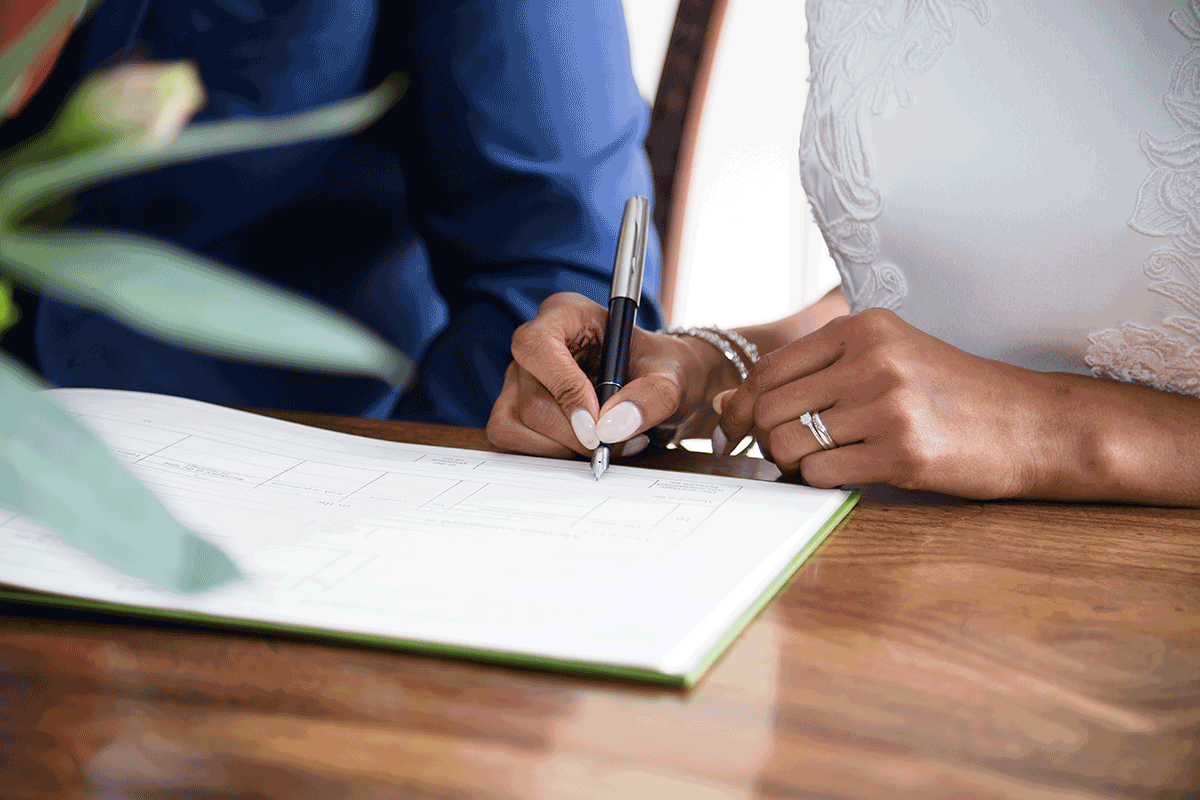From making it legal to observing Scottish traditions, here's everything you need to know about planning your wedding ceremony in Scotland
You're getting married, congratulations! There's a lot that goes into planning a wedding, but there are a few key things you need to do to make your wedding ceremony legally binding, and not just a lavish party.
To help you get stuck into planning, we've put together a guide of everything you need to know about wedding ceremonies in Scotland.
What to do before the ceremony
There's a bit of prep to do before your wedding ceremony, and it's more than just deciding what music to walk in to!
What is an M10 form?
To get married in Scotland, both parties must sign the Marriage Notice Application Form, also known as the M10 form and each person must fill out one copy each. For a Civil partnership, it's the CP10 form.
When to submit and collect the M10 form
You will submit the M10 form to the registry office closest to the location of the ceremony (which might not be your local registry office!) no earlier than 12 weeks before and no later than 29 days before your wedding.
If you're having a religious or belief ceremony, you or your partner must collect and sign for this document no more than seven days prior to the ceremony. After the wedding you have three days to return the marriage schedule to the same registry office where you submitted your M10 form.
If your marriage is being conducted by a civil registrar, they bring the schedule for completion on the day of the marriage and return it thereafter.
How much does a marriage licence cost?
The process costs £100. It is broken down as £45 per applicant and £10 for the marriage certificate.
What paperwork will I need?
To fill out the M10 forms, you both will need your birth certificates, passports or drivers licenses, and proof of address. If either of you have been married before you will also need to show you are no longer married with a divorce decree or death certificate of your former spouse.
Does the paperwork change depending on the type of ceremony?
Regardless of who does the honours or where the marriage takes place, you still need to follow the same legal process, explains celebrant Natalie Stevenson: “You need two sets of Marriage Notice forms (also known as M10 forms). You each fill in a set of these forms.”
Choose your celebrant or registrar
Figure out which type of ceremony you'd like to have – civil or belief.
For a civil ceremony, the local registry office will provide one of its registrars or assistant registrars to conduct the ceremony.
If you chose to have a humanist or interfaith 'belief' ceremony, you should then look for a celebrant you think you'd like to conduct your ceremony.
For that sort of ceremony, when you've booked someone, you'll likely meet with them several times so they can get to know you as a couple and create a truly personal ceremony.
For a religious 'belief' ceremony, the religious organisation will usually provide a representative such as a by minister or other authorised belief celebrant.
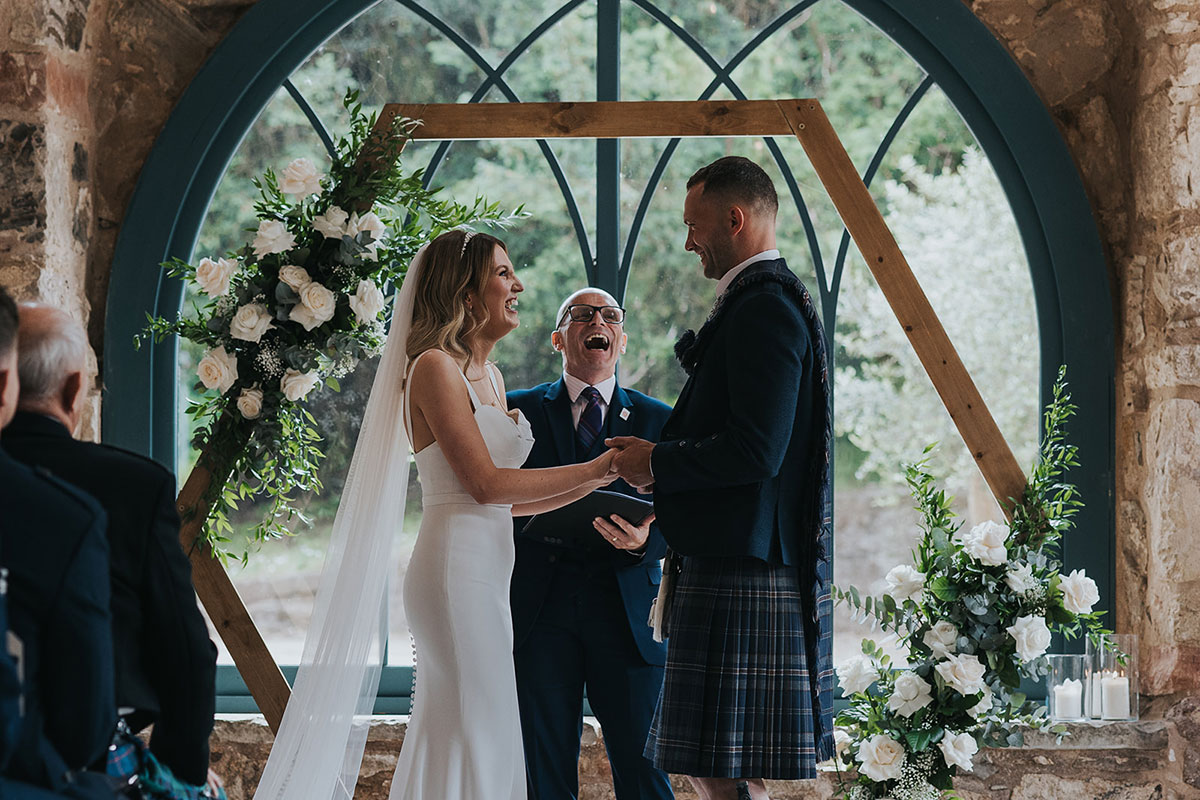
Fun ceremonies are what George McLean at Fuze Ceremonies prides himself on (Photo: Jen Owens Images)
How far in advance should I book the celebrant or registrar?
“Generally speaking, once you have your venue, you should look at getting someone to marry you,” suggests celebrant Craig Flowers. “About a year or 18 months ahead is a good time to book. Likewise, celebrants can work on short notice, so it is always worth reaching out if there’s someone you like.”
What is a humanist celebrant?
A celebrant is a person who is there with you to celebrate a life event.
Humanism, in the words of Humanist Society Scotland, is a non-religious approach to living an ethical life that is based on reason, compassion and tolerance.
Looking for something with a religious overtone? A celebrant might not be for you. “Humanist celebrants offer a non-religious celebration of the couple’s union,” says George McLean of Fuze Ceremonies.
“Instead of including religious moments, the content of the ceremony is about the couple’s love story, that’s the real ‘showpiece’. Over the process of creating the ceremony, we get to know our couples really well.
"We get to take them (and their guests) on a journey of their love, with everything from their first holiday together to their proposal story being told, if that’s what they want.”
Some celebrants are happy for a loved one to say something religious during the ceremony, but not all, so do check in advance if this is possible.
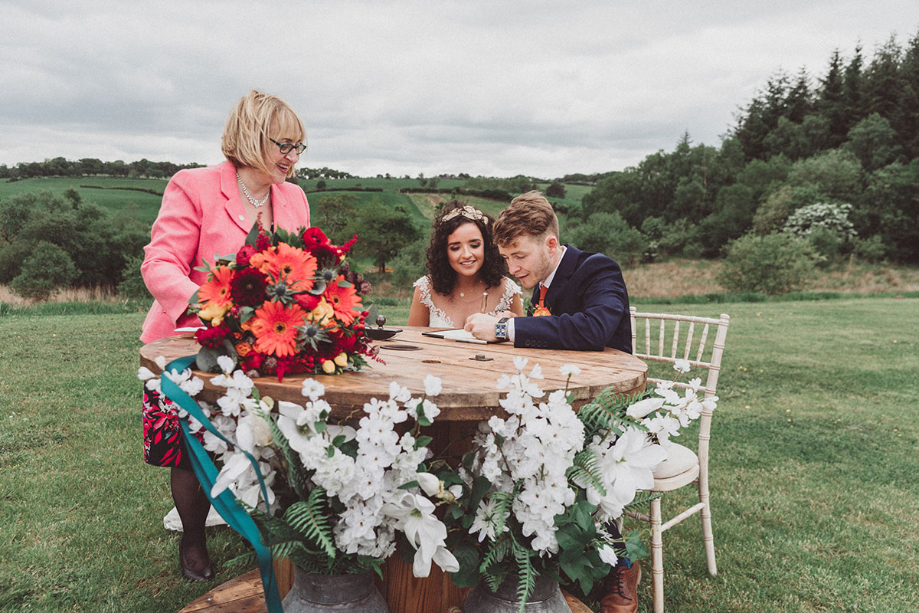
Maureen Kettle, Humanist Society Scotland oversees the bride and groom signing the Marriage Schedule (Photo: Victoria Charlotte Rose)
How much does a celebrant cost to book?
Typically you may be looking at a celebrant fee of about £450 to £650 depending on who you book and which organisation you book with.
In the Church of Scotland, Rev Jillian Storrie says, there is no charge for a wedding.
Other religious organisations will not charge for the actual marriage to take place, but there could be costs for using the church and whether you want extras such as an organist or a choir.
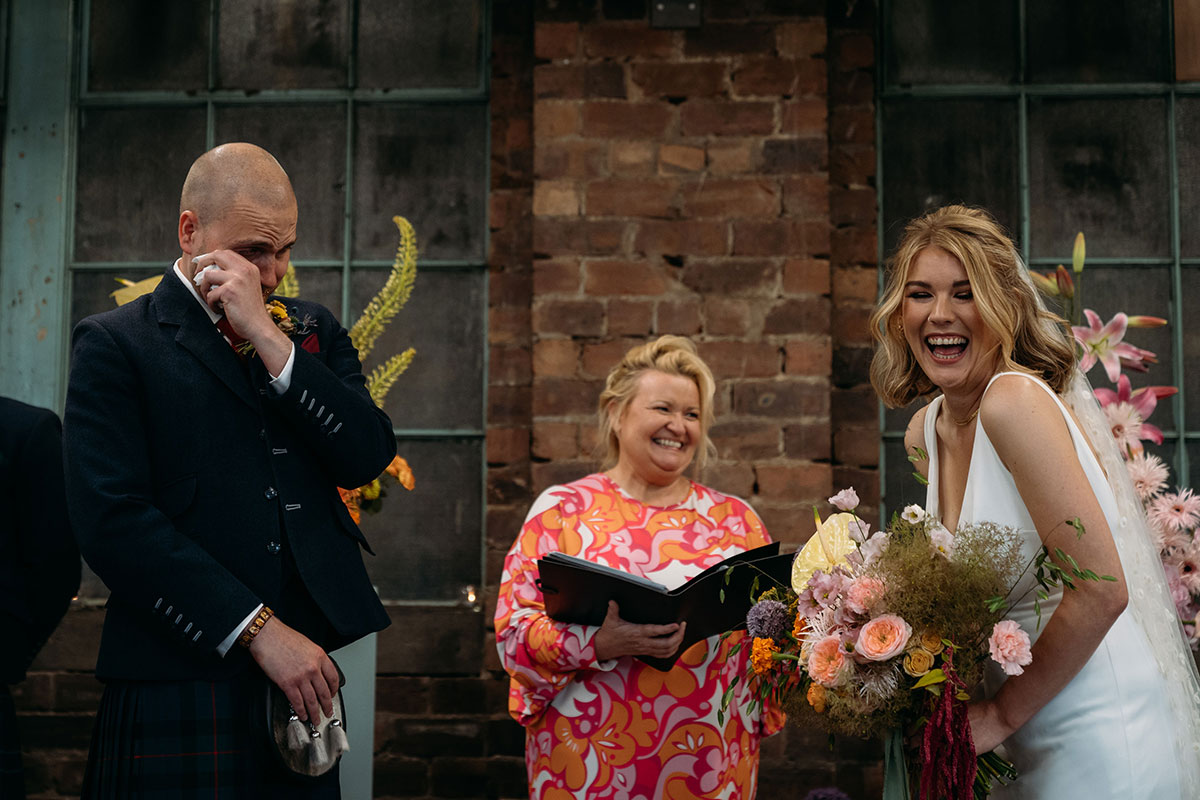
Humanist Society Scotland have over 100 celebrants across the country (Photo: Jo + Liam Photography)
The legal part of a wedding ceremony
While a lot of wedding planning is all of the fun things – decor, outfits, food and drinks – there are a few things you must do in order to be legally married.
There are two legal parts during the ceremony that allow you to officially become married. The first is when you say out loud that you are taking the other person to be your husband/wife, the other is when you sign the marriage schedule.
Gemma Sinclair of Humanist Society Scotland explains: “Your celebrant and witnesses must hear each of you saying ‘I name accept you, name, in marriage’, although other words can be added in and around these. You can use just first names or full names, and your celebrant will declare you married using the same names.”
Signing the marriage schedule
The registrar uses the information you give on your M10 forms to produce the Marriage Schedule – this is the document you as newlyweds (and your witnesses) will sign after the ceremony.
After you’ve made your legal declarations during the ceremony, the two of you, your celebrant/registrar and two witnesses must sign the marriage schedule. Your witnesses can be anyone, provided they are at least 16 years old on the day.
You must sign the schedule using indelible black ink, and your celebrant or registrar will provide a fountain pen for this purpose.
Who can get married in Scotland?
This is probably obvious, but let’s spell out the key requirements you must meet. Both halves of the couple must be aged 16 or above. They cannot be already married or in a civil partnership with someone else. They must be of sound and consenting mind. And they can’t be closely related.
Where can I get married in Scotland?
As long as you follow the legal steps above and have a celebrant and two witnesses with you, you can get married anywhere in Scotland.
Whether you want to get married in your back garden or in a super-luxe barn, this is possible in Scotland, says George McLean at Fuze Ceremonies: “The location of your ceremony is totally up to you, and as long as you have permission to be in that place, we can make it happen.”
Rev Jillian Storrie of the Church of Scotland is keen to dispel any misconceptions about religious ceremonies: “You can choose to have a religious ceremony anywhere – there is actually no need to be married in a religious building,” she says.
“Likewise, you don’t even need to be a member of the Church; you are still welcome to get married by a minister or in a religious building.”

Gorgeous outdoor ceremony set-up by 360 Event Hire
What does a wedding ceremony involve?
While there are a couple of legal requirements for a wedding ceremony – a specific phrase you have to say and signing the marriage license – there are lots of things you can do to make your ceremony your own.
Types of wedding ceremonies
There are two types of marriage ceremonies in Scotland: civil ceremonies and religious/belief ceremonies.
Civil ceremonies can take place in a registration office or anywhere agreed with the registrar – except on religious premises.
Meanwhile, religious or belief ceremonies (that includes humanist and interfaith) can take place almost anywhere, as long as they are led by someone approved to conduct that type of ceremony.
Can a religious ceremony be personalised?
“It’s a myth that religious ceremonies are ‘too holy’ or too formal – they are all actually tailor-made and are completely centred around the couple, so if you want hymns or don’t want a sermon, that’s your call,” says Rev Jillian Storrie.
“Ministers get to know the couple over the course of many meetings – we can meet as many times as it takes to get it right.
"The difference is that during the wedding we are gathered in the presence of God and the couple are married in the eyes of God.”
Do you need to personalise your wedding ceremony?
The person marrying you should be happy to take your lead and can go as traditional or unique as you wish. The only thing that matters is that you sign the paperwork and are officially declared married in front of your witnesses.
Looking for a piper to play you into the ceremony? Or a bird of prey to deliver your rings? We round up all of the types of entertainment you can have at your wedding
Do all registrars and celebrants carry out same-sex weddings?
All civil registrars and humanist organisations will carry out same-sex ceremonies.
Many Church of Scotland ministers are happy to officiate at gay weddings, says Rev Jillian Storrie. However, some religious bodies will only marry heterosexual couples so make sure you check this when choosing someone to marry you.
“Many ministers are now carrying out same-sex ceremonies as we want to be more inclusive,” Rev. Jillian smiles. “God loves everyone, so I am really proud to be able to do this.”
How long does a wedding ceremony in Scotland last?
“The timings are entirely dependent on what you think is best for you, although certain venues may have time limits,” Craig Flowers of Independent Humanist Ceremonies tells us.
“Generally speaking, the average wedding ceremony is about 30 minutes. It shouldn’t feel too rushed, but equally, you don’t want your guests to be sitting for hours. It’s entirely up to you, but I’d suggest keeping it between 25 and 45 minutes."
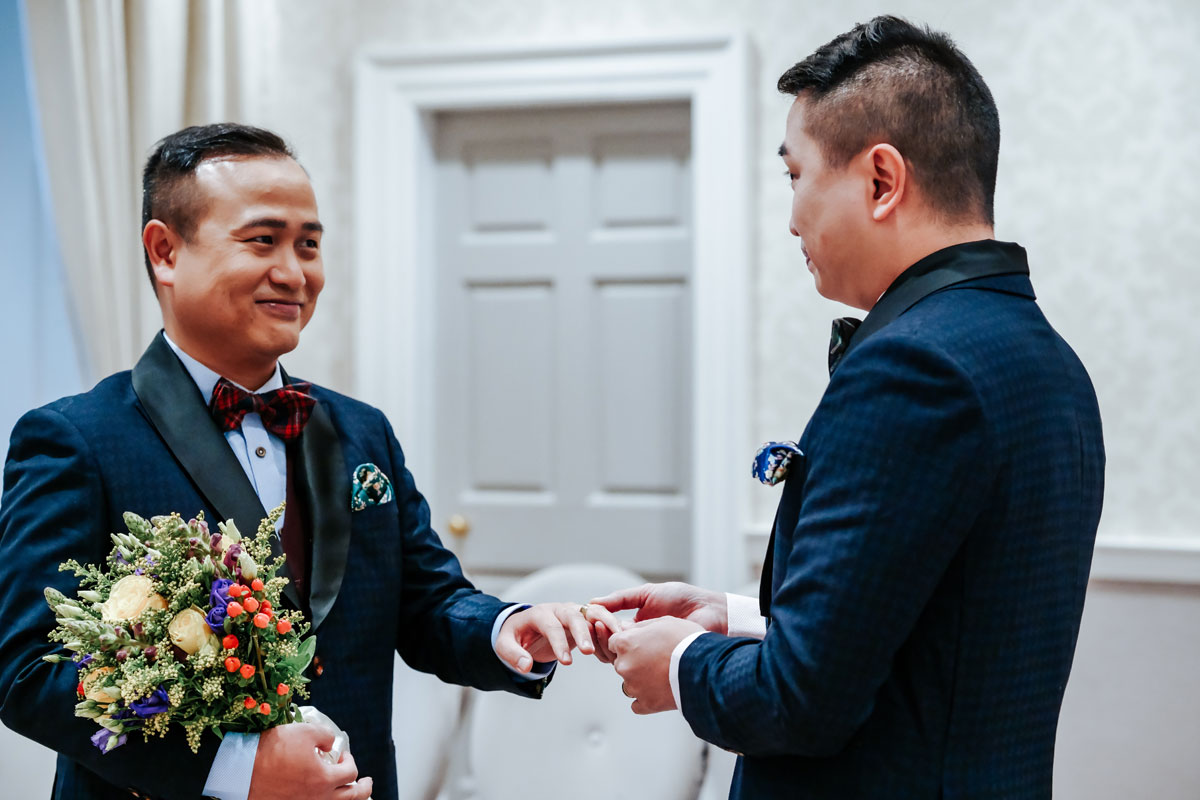
(Photo: Dougi McMillan Photography)
What happens during a non-religious wedding ceremony?
A non-religious wedding ceremony will typically follow the structure of:
Entering the ceremony
This often sees one half of the couple waiting at the end of the aisle with their wedding party while the the other half of the couple and the rest of the wedding party walk in to join them. However some couples do choose to both walk in separately or even walk in together.
Welcome and beginning the ceremony
Your celebrant or registrar will welcome everyone and introduce you as a couple.
Readings and rituals
What you would like to fill your ceremony with is up to you, but this is a good time for readings from loved ones or incorporating rituals and traditions like handfasting or drinking from the quaich.
Exchanging vows
The celebrant or registrar will address the couple and you will say your vows. This can be traditional vows or your own written vows, as long as you make a few specific declarations (which your celebrant or registrar will help you with).
They will also ask if there's any reason you should not be married, and since this isn't a soap opera no one should burst through the doors at this moment!
Exchanging the rings
It is traditional to exchange rings at this stage in the ceremony, however this isn't a legal requirement. Some couples also incorporate a ring warming to lead up to this moment.
Declaration of marriage
You will then be pronounced married! This is also the moment for the iconic first kiss – a great photo opportunity!
Signing the register
Hold on, you're actually not quite married just yet. You'll need to sign the marriage schedule, and this sometimes is done in front of your guests and sometimes happens in another room off to the side. This is another great moment for your photographer to capture.
You'll need two witnesses to sign the schedule too. At this point it's a nice idea to have some music playing or a reading presented to keep your guests entertained.
Ending the ceremony
The officiant will likely make closing remarks to signal the end of the ceremony and send you off as a married couple.
Leaving the ceremony
Typically the newlyweds will walk back up the aisle holding hands, celebrating and maybe even go for a dip and kiss for the camera.
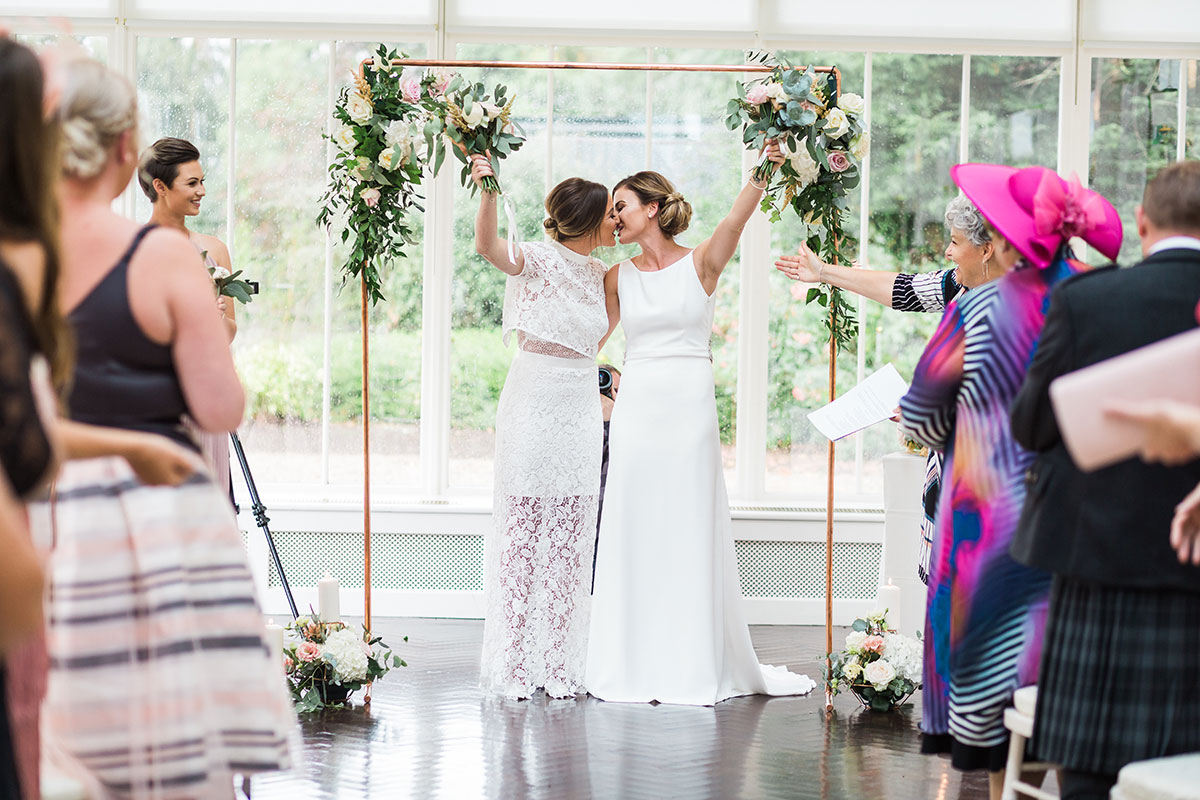
(Photo: Solen Photography)
What happens during a church wedding ceremony?
This will vary depending on which church you are with, but a religious ceremony will be officiated by a member of the clergy and will roughly follow these steps:
Entering the ceremony
The wedding party enter the ceremony, traditionally as a procession with the guests upstanding.
Welcome and beginning the ceremony
The officiant will welcome everyone and often a hymn is sung and/or a prayer is said. They will also introduce you as a couple and discuss the purpose of marriage.
Readings
The officiant or your guests can read Bible passages and sometimes reading from other texts.
Declarations
The officiant will ask if there is any reason the couple cannot be married. You will then be asked in turn about your commitment to each other.
Exchanging vows
You will then say your vows to each other, guided by the officiant. Some churches may allow you to write your own vows in addition to the traditional church vows, but you will need to have them approved by the officiant ahead of the ceremony.
Exchanging the rings
The rings will be blessed by the officiant and then you will place your partner's ring on their finger. At this point you might say another vow to each other, along the lines of "with this ring I..." or "I give this ring as a sign of our marriage..."
Readings and rituals
This is your chance to have other readings included or rituals carried out that are important to you as a couple.
Declaration of marriage
The officiant will say a blessing and you will then be pronounced married! You can choose to have your first kiss at this point too.
Signing the register
You'll then sign the marriage schedule along with your two witnesses, either in front of your guests or in another room off of the ceremony space.
Prayers
The officiant will lead the guests in formal prayers. Sometimes they will also have the couple kneel and or stand before the alter to receive a blessing.
There will then be a final prayer and/or hymn.
End of the ceremony
The newlyweds will exit the church followed by the wedding party and the guests. Your photographer will be there to capture this magical moment.
What is a belief ceremony?
A belief ceremony is one that is based on a belief system such as humanism, philosophy or religion and is performed by a relevant representative of this belief.
What is an agnostic ceremony?
Unlike a humanist ceremony which doesn't include any religious content, an agnostic ceremony can include both religious ad non-religious elements as it is all depending on the couple's individual beliefs.
What happens during a civil ceremony at a registry office?
Much of the process of a registry office ceremony is the same as other ceremonies, but it will be more brief and likely with a smaller guest list.
You'll still need to fill out the Marriage Notice Form ahead of time and send it to the registrar in the area you're getting married in. This needs to be done between three months and one month before your wedding day.
The registrar will bring your marriage schedule to the ceremony and will return it to the registrar's office afterwards.
You can choose to do readings during most ceremonies, however religious readings are not allowed at a registry office wedding. You will say vows, can exchange rings and will sign the marriage schedule as you would in any other ceremony.
Can I elope in Scotland?
Yes, you can get married anywhere in Scotland, so take your pick of incredible locations!
You can almost get married just the two of you, but you will need someone to officiate the ceremony as well as two witnesses (one of which can be your officiant).
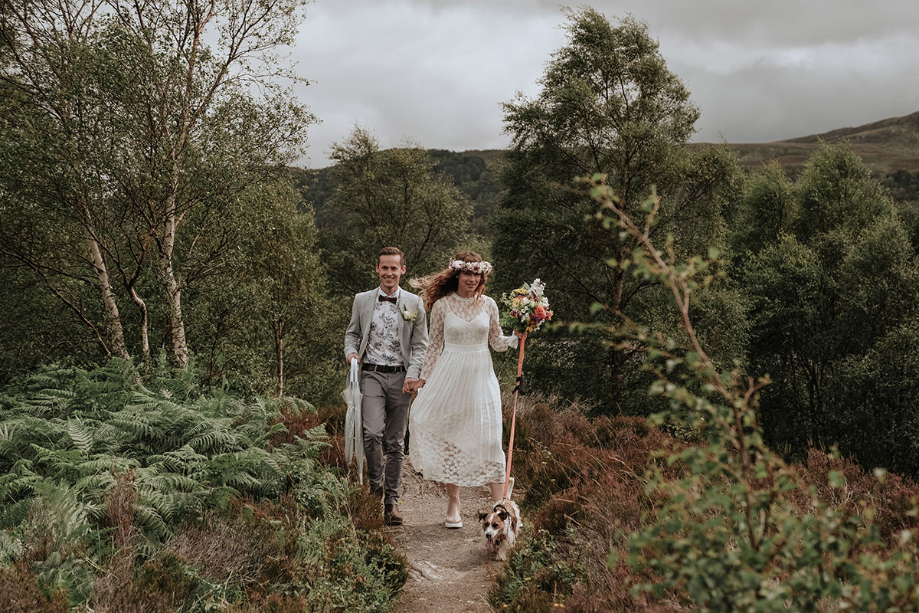
(Photo: Allan Law Photography)
The readings
If you are having a humanist ceremony, you can include readings of poems, book passages or quotes read by yourselves or loved ones.
For a religious ceremony, people tend to have Bible readings during the ceremony.
Get inspired by these 10 wedding ceremony readings
Writing your vows
You often have the option to write your own vows or you can use the standard vows for your ceremony type. Chat to your celebrant to get a steer on what kind of things to include and how long your vows can be.
"You read at a different pace in your head, so I would recommend practicing reading your vows out loud to time them. Keep in mind that it may take longer for readings and vows due to emotions and happy tears on the day," suggests Gemma Sinclair of Humanist Society Scotland.
See more tips for writing your wedding vows

(Photo: Cara Frew Photography)
Wedding rituals and traditions
There is an array of Scottish wedding traditions as well as wedding traditions from other parts of the world that are commonly incorporated into ceremonies. Here are just a few popular ones...
Handfasting
Handfasting is an ancient Celtic marriage ritual and is thought to be where the expression ‘tying the knot’ comes from. During the ritual, the couples hands are bound together with two pieces of fabric – often in the couple's family tartans or with another significant piece of material. This symbolises your union to each other.
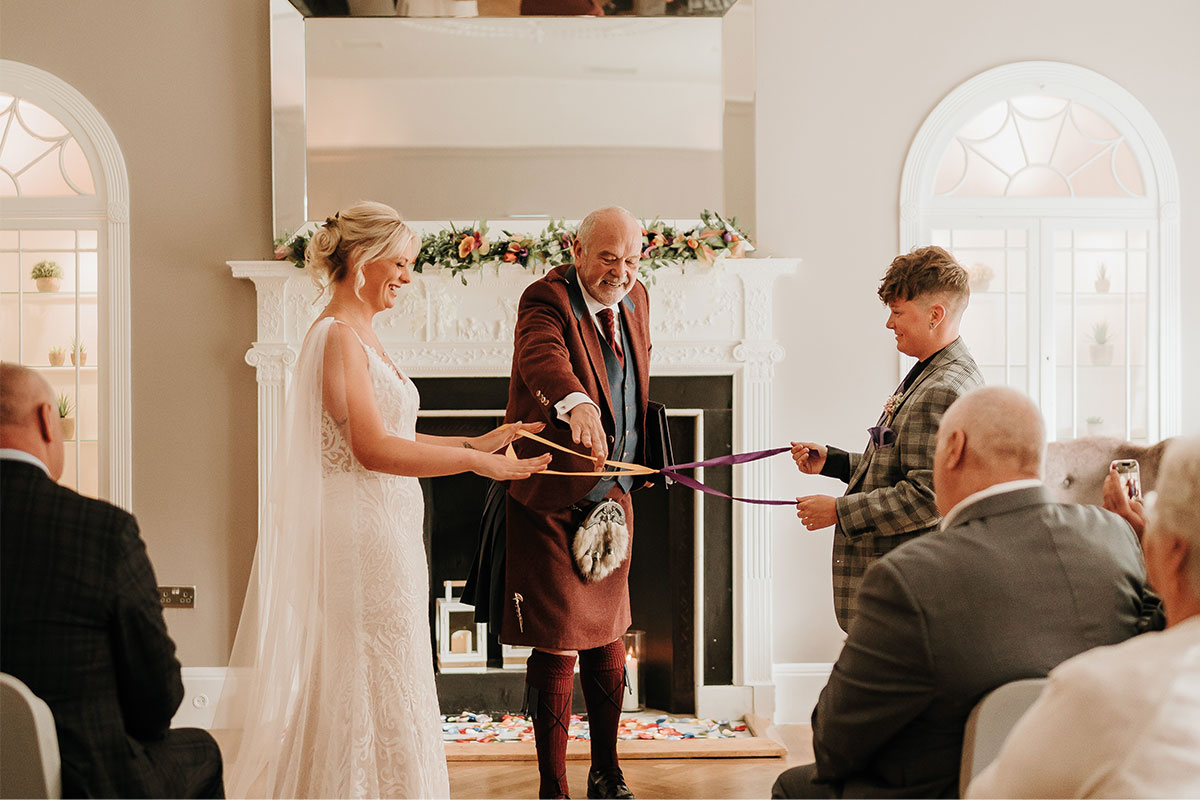
(Photo: For Love & Thistle Photography)
Drinking from the quaich
“Quaich is the Gaelic word for ‘cup of friendship’ or ‘loving cup’,” says independent celebrant Natalie Stevenson.
“Way back when, new clan members would be welcomed by being given the gift of the quaich. Whisky, the ‘water of life’, was the traditional tipple. Nowadays couples will often have their first drink together as newlyweds by sipping from a quaich and I will give them a little toast just after they have signed the schedule."
If you and your spouse are not whisky fans, you can still have the quaich in your ceremony and use whatever drink you fancy.
Sand ceremony
A lovely way to symbolise the bringing together of blended families is with a sand ceremony. “This is when two (or more) people take sand from individual vessels and bring them together in one larger vessel,” says Craig Aikman of Independent Humanist Ceremonies.
“It can be any sand of your choosing, but it looks great if it’s in different colours, especially if there are children involved – a nice visual way to encapsulate that 'coming together’. I’d recommend testing that the sand actually pours from the vessel before the ceremony – I’ve known situations where it hasn’t come out properly. Had they not taken the lids off, it could’ve been a very long ceremony!”
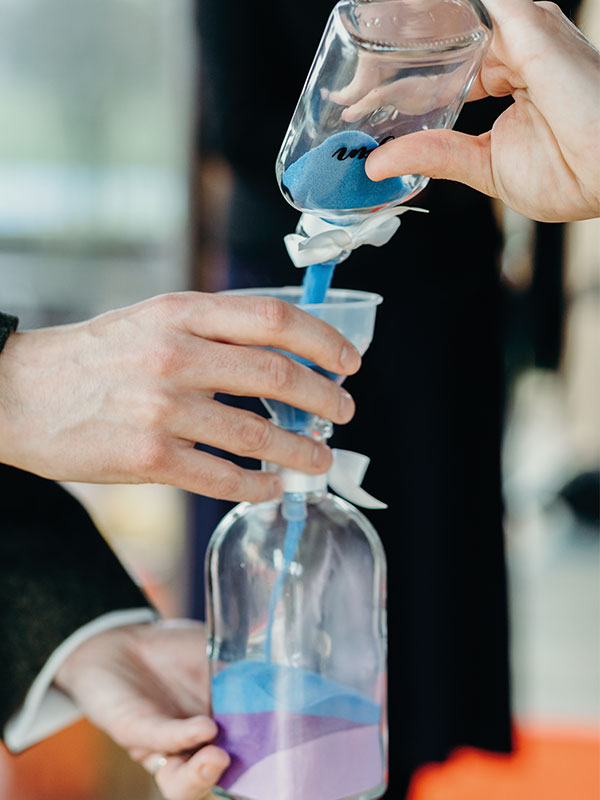
(Photo: Solen Collet)
Lighting a candle
A candle can be lit by the couple and allowed to burn throughout the ceremony as a way to pay tribute to a loved one who is sadly no longer here.
Alternatively a candle can symbolise two families coming together, when both halves of the couple light a candle each and use them to light a larger candle together. You can even involve your family in this by asking loved ones to light the candles for you.
Ring warming
This is a real crowd-pleaser and a lovely way to involve guests. Pass your wedding bands around your seated guests and ask them to whisper words of love and luck as they hold the rings.
Oathing stones
This is an old Scottish tradition where the couple hold a stone while saying their vows, then cast it into a river. This is where the saying ‘set in stone’ derives from, celebrant Paul Browett tells us: “I always suggest a stone that’s meaningful in some way. You could even have it engraved with your names or dates.”
Paying tribute to loved ones who have passed
There are lots of ways you can pay tribute to someone who sadly can't be at your wedding.
Have a think about what feels right for you, but some ideas we've seen include:
- Save them a seat – leave a chair empty for them, perhaps with their photo or name on it
- Light a candle for them to burn brightly during the ceremony
- Wear something of theirs or something that reminds you of them on the day, from jewellery to a colour
- Having their photo, a charm or something of theirs incorporated into your bouquet or boutonniere. Alternatively you could use their favourite flower
- Setting up a tribute table with the photos of loved ones, maybe even include their wedding photos
- Use a piece of fabric that is symbolic for your handfasting, such as a strip of fabric from a piece of their clothing, their tie or a scarf, or tartan from their clan
- Toast to them during the ceremony, if you're drinking from the quaich this is a great time incorporate this. For a more subtle nod to your loved one, why not use their favourite drink?
- Have someone say a reading or poem that reminds you of them
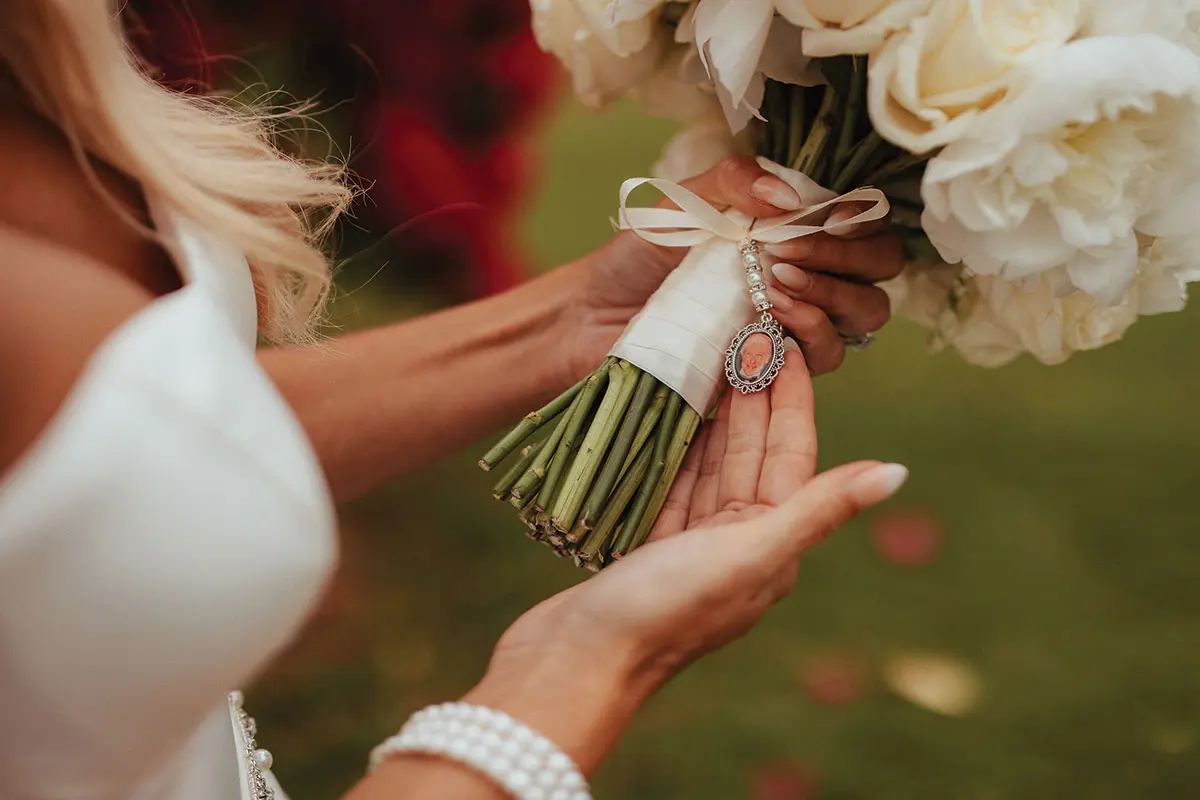
(Photo: White Cherrie Photography)
After the wedding
When and where to return the M10 marriage license
You have three days from the wedding to return the marriage schedule to the same registry office where you submitted your M10 form. (If you are giving the paperwork to someone else to return, make sure they are trustworthy.)
If your marriage is being conducted by a civil registrar, they will retain the schedule for completion on the day of the marriage (and return it thereafter).
Changing your name
If you're changing your name after getting married there are many places you'll need to notify so your records can be updated, including but not limited to:
- Passport
- Driver's licence
- Local authority for council tax and electoral register
- HMRC
- Your bank
- Doctor, dentist and other medical records
- Insurance companies
And anywhere else that has your details saved on file. Check with each place on their specific process for changing your name. You may also need to update your marital status when updating these places with your new details.
If you're going on a honeymoon, make sure the name on your passport matches your travel documents.
Read our guide for legally changing your name in Scotland after marriage for more advice
Return borrowed and rented items
From decor to kilts, make sure you know when any items you rented are due back and make a plan to get them returned. If you're heading off on honeymoon straight away, appoint a trusted person to take care of this for you.

